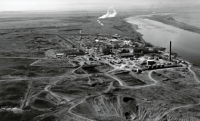A Track Record of Protecting the Columbia
Since 2000, Columbia Riverkeeper and our partners have advocated for effective, timely cleanup at Hanford. Together, we have:
Successfully advocated that U.S. government regulators address toxic hexavalent chromium contamination, which was upwelling into salmon habitat near retired plutonium reactors. The government delved into cleanup with deep digs in the River Corridor, reducing the amount of chromium entering the river.
Encouraged the U.S. Dept. of Energy to invest in groundwater treatment. Now the massive pump-and-treat system near some of the worst pollution at Hanford has treated billions of gallons of groundwater, removing tons of toxic and radioactive pollution before it can reach the Columbia.
Blocked multiple proposals to make Hanford a dump site for so-called “Greater Than Class C” radioactive waste and toxic mercury waste. Th e mission at Hanford must be cleanup, not dumping ground.
Engaged our members to challenge the Trump administration’s proposal to reduce the size of the Hanford Reach National Monument—and won. The Trump administration’s shortsighted proposal could have jeopardized the Hanford Reach’s natural, cultural, and fisheries resources. No matter how long it takes, Columbia Riverkeeper will advocate for cleanup at Hanford.
Stand Up for Cleanup
Decades after ceasing plutonium production, the Hanford Nuclear Site remains the most toxic and radioactive place in the Western Hemisphere. Th e stark reality: contamination from Hanford still reaches the Columbia River. Without effective cleanup, more pollution threatens to escape into the environment in the coming decades. For example, at Hanford, cancer-causing strontium-90 levels in groundwater near the Columbia are 2000 times above the drinking water standard. Radiation levels in soils are lethally dangerous just a few hundred yards from the Columbia. Cleanup along the Columbia remains far from complete.
Let’s not forget about climate change and earthquakes. From threatening the stability of aging infrastructure to changing the movement of radioactive and toxic groundwater from increased rainfall, climate change poses unique risks at Hanford. Like some sort of twisted golden ticket, when talking about nuclear threats, earthquakes, and climate change risks to humanity, Hanford has it all.
Five Ways You Will Make a Difference in 2023
1. Advocate for River Corridor and Groundwater Cleanup: Columba Riverkeeper is calling on the U.S. Dept. of Energy (Energy) to address pollution near the Columbia in a way that protects people’s health and the environment. Energy’s cleanup plans should not permanently restrict access to large tracts of the so-called River Corridor. Instead, those plans should maximize returning the Columbia to unrestricted use and honor Tribes’ treaty reserved rights to use Hanford.
2. Oppose Proposals to Shortcut Cleanup of High-Level Waste: Energy must treat high-level waste as the law requires. Th is means Energy must treat, immobilize, and remove high-level waste from Hanford. Energy’s proposals to redefine high-level waste, abandon high-level waste in tanks, or use shortcuts that limit short-term costs (such as using unproven grout rather than turning waste into a glass) would prolong and exacerbate risks to groundwater. Th at’s why Columbia Riverkeeper continues to vocally oppose cleanup shortcuts.
3. Prevent Tank Leaks: Today, there are 177 underground storage tanks at Hanford, holding about 56 million gallons of highly radioactive and chemically hazardous waste. According to the Washington Dept. of Ecology (Ecology), all of the tanks are well past their design life of about 25 years, and at least 67 are assumed to have leaked in the past, and two are currently leaking. More than one million gallons have leaked from the tanks. Columbia Riverkeeper will continue to advocate for Energy and Ecology to accelerate efforts to prevent future tank leaks, respond to leaks where they occur, and address tanks that have already failed.
4. Prioritize Cleanup at the Waste Encapsulation Storage Facility: Columbia Riverkeeper is advocating for Energy to move as quickly as possible to remove highly radioactive cesium and strontium capsules from the Waste Encapsulation Storage Facility (WESF), the highest-risk facility at Hanford. WESF contains tens of millions of curies of radioactive material, almost one-third of all the radioactivity in Hanford’s waste sites. If the aging water-filled basins were to fail, cesium and strontium could be released into the environment.
5. Spotlight the Risks of New Commercial Nuclear Reactors: As if cleaning up the legacy of nuclear weapons production wasn’t enough, a company, X-energy, proposed siting small modular nuclear reactors (SMR) at Hanford on property leased to private entities. It’s a bad idea. In 2021, Columbia Riverkeeper released an in-depth report on SMRs at Hanford and sounded the alarm. Great news: In March 2023, X-Energy withdrew its proposal. Columbia Riverkeeper will continue to track and raise awareness about proposals to increase commercial nuclear reactors near the river.
To ensure the complete and timely cleanup of the Hanford Nuclear Site, we review and critique cleanup and restoration plans.
The fight to clean up the most polluted place in America.
Add your voice to the growing number of people holding the U.S. government accountable for decades of nuclear-waste pollution.
Want to hear all the stories from Columbia Riverkeeper's Currents Issue 1, 2023 Newsletter?




